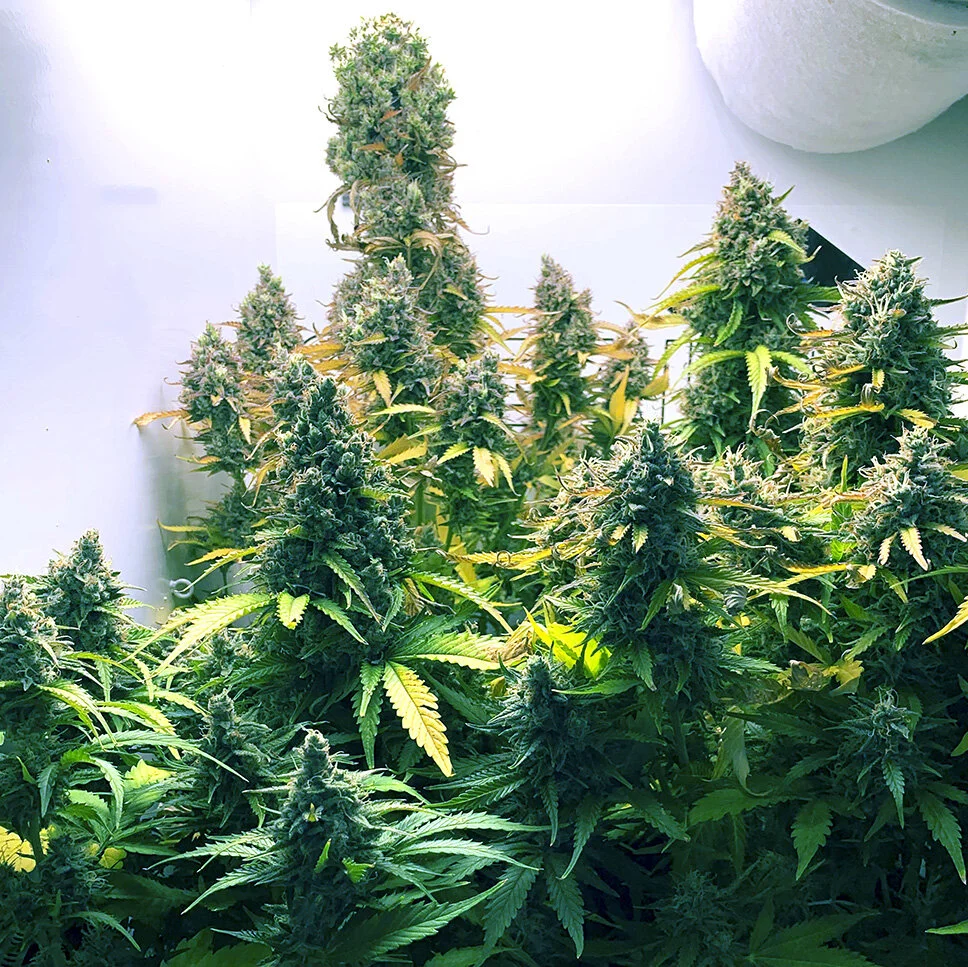Autoflower vs. Photo-period Cannabis
Seen here: White Widow autoflower from Crop King Seeds - the record-breaking grow of 7.8 oz!
Cannabis classifications
Everyone has heard of indica and sativa – the most well-known classifications of cannabis. While the unique psychoactive properties of each type are up for debate, these distinctions remain important for growers as they describe the morphology (or structure) of your plant. Working in a small space like Stealth Box, you’re going to want to select an indica-leaning strain, as these strains favour a low profile (unlike sativa strains which are likely to overgrow such a small space).
the origins of cannabis ruderalis
Beyond indica and sativa, however, is a third variety: cannabis ruderalis. This strain of cannabis evolved quietly without human intervention in the mountains of Russia, only to be discovered in the 90’s. Ruderalis had some unique properties which distinguished it from the other types of cannabis already on the market at the time. Most cannabis plants are photo-period; this means as a grower you control when the plants go into flower (and start producing buds) by reducing light hours to mimic autumn conditions. Ruderalis, meanwhile, will go into flower whether or not you change the light cycle. Instead, this unique type of cannabis follows its own internal timeline which tells it when to begin producing buds, which it will do automatically – this plant is “autoflowering”, as strains crossed with ruderalis are often named.
Because cannabis ruderalis evolved in the harsh conditions of Russia (as well as other parts of Asia and Eastern Europe), it has a short life cycle and can handle up to 24 hours of light. It would have needed to adapt in this fashion in order to survive the short Russian summers where the sun barely sets. Where ruderalis was once considered a wild breed, it has since been bred with more popular photo period strains to enhance its yield and strength.
modern autoflowers
There are many misconceptions about autoflower strains which stem from its roots as a wild plant. Wild ruderalis is short in stature, low-THC, and provides a lower yield than modern photo-period strains (which have been bred for several millennia to increase strength and yield). This earned autoflowering genetics a name for low yields and weak buds, however this is frequently no longer true. Modern breeders have vigorously incorporated ruderalis into their roster, and many autoflower strains on the market contain as little as 10% ruderalis.
What this means is that the plant takes the majority of its genetic profile from its photo-period lineage, boosting the yield and strength of the plant, while maintaining it’s “autoflowering” nature. The result is plants that have a quicker grow cycle, require less fiddling with the light schedule, less training and pruning, and will yield almost as much if not more than some photo-period strains. In fact, the highest yielding Stealth Box grow to date (7.8 oz) was achieved using an autoflower strain. Yield aside, there are many autoflower genetics available boasting up to 30% cannabinoid content – a far cry from its low THC heritage.
a compact plant for a compact grow environment
Autoflower strains are well-suited to growing in small environments such as Stealth Box. The first consideration as a grower is the differences in lighting cycles. Depending on what strain you’re growing, you may want to choose an 18 hrs on/6 hrs off light cycle (this cycle is tried and true), or you can simply leave the light on. If you choose to go with 24 hours of light, be sure to keep an eye on your plant for signs of flowering.
Because the ruderalis genetic takes a back seat to the photo-period genetics in most modern autoflower strains (generally a 90%/10% mix), it is a good idea to be aware that not all autoflower genetics will flower automatically under a 24 hour schedule. Autoflowers generally flower by week 3-4, so if you do not see any signs of flower by the end of week 4-5 (such as white hairs at the nodes), consider changing your light cycle to 12/12 to force your plants into making buds.
autoflower care in Stealth box
When handling autoflower plants, bear in mind that these plants are a bit more delicate than your standard cannabis plant. You will want to take care when you transplant these seedlings from the seedling dome to their cloth pots, as their root network is more fragile and vulnerable than other types of cannabis. When it comes time for training, only light stress training methods are recommended as high stress training will stunt the growth of your plants. Autoflower plants follow their own internal timeline and start flower when they please, so there is no opportunity for correction if your plants are stunted – you will simply lose yield. Techniques to avoid include topping and super cropping (read more about training here).
Autoflower plants aren’t generally super leafy, so there shouldn’t be a huge need to defoliate. While you can still feel free to remove or tuck away any leaves that are blocking light from the bud sites throughout flower, you will find these plants need less pruning and attention to bring to harvest. An excellent attribute of autoflowers is that you will not need to worry about determining when your plants should begin flower – nature takes care of this for you. Some autoflower plants can be harvested as quickly as 8 weeks from germination, which allows you to increase your number of annual grows from 3 to 4 – a hefty boost to your annual yield!
final thoughts
Modern autoflowers have come a long way from their roots as a wild plant, but genetics are still going to be the deciding factor for a successful grow. Bad autoflower genetics may still have some of the plant’s less desirable natural traits, but good autoflower strains will give you an excellent yield and high while reducing your work load as a grower. Feel free to send us a message and we’ll point you in the right direction for great autoflower genetics!

